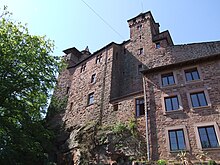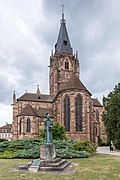Berwartstein Castle
| Berwartstein | ||
|---|---|---|
|
Berwartstein Castle from the south (from Little France ) |
||
| Alternative name (s): | Bärbelstein, Bärwelstein | |
| Creation time : | before 1152 | |
| Castle type : | Höhenburg, rocky location | |
| Conservation status: | Received or received substantial parts | |
| Standing position : | Ministerials | |
| Construction: | Hunchback cuboid with pincer holes | |
| Place: | Erlenbach near Dahn | |
| Geographical location | 49 ° 6 '30 " N , 7 ° 51' 46" E | |
| Height: | 280 m above sea level NHN | |
|
|
||
The Berwartstein , always with an article, also known as Bärbelstein or (in Palatine ) Bärwelstein , is a medieval rock castle in the southern Palatinate Forest , the German part of Wasgau ( Rhineland-Palatinate ). The castle was rebuilt in the 1890s - 300 years after it was destroyed by lightning - and is the only one in the Wasgau that is still inhabited.
The nearby Vorwerk Klein-France used to belong to the Berwartstein .
geography
location

The Berwartstein is about 280 m above sea level. NHN on a hilltop south above the local community Erlenbach near Dahn in the district of Südwestpfalz . The side valley that he dominates and through which the Erlenbach flows, flows about 3 km south between Dahn and Wissembourg (German: Weißenburg) from the left into the valley of the Lauter , which is called "Wieslauter" here on the upper reaches.
On the northern slope of the 402 m high Nestelberg , south opposite the main castle and 370 m as the crow flies, are the ruins of the Vorwerk Klein-Frankreich .
The Berwartstein is managed and accessible not only for hikers but also for motor vehicles. However, there are only a few parking spaces available in the former courtyard, while a larger parking lot has been created below the castle. The journey leads from Dahn on the federal road 427 (direction Bad Bergzabern ), the state road 490 (direction Niederschlettenbach ) and the district road 50 (direction Berwartstein). From the K 50, the access road to Berwartstein branches off to the top right.
Surroundings
There are other historic castles in the vicinity of the Berwartstein: The Drachenfels , which was destroyed in 1523 because of the rebellious knight Franz von Sickingen , is 3 km, the Altdahn – Grafendahn – Tanstein group of castles is about 5 km northwest. The Lindelbrunn Castle is located about 6 km north-east and four times the Castle Group on the German- French border with Wegelnburg (German) and Hohenburg , Lowenstein and Fleckenstein (all on the French side) in the Southwest is 10 km away.
Castle complex
Superstructures and equipment
Because of its numerous rocks and castles, the south-western part of the Wasgau, whose center is the small town of Dahn, is called Dahner Felsenland ; Sport climbers will find numerous climbing rocks there . Like many other castles in the area, the Berwartstein is a rock castle largely carved into the natural sandstone . In addition, the Drachenfels and the Dahner Burgengruppe are considered to be the main representatives of this type of castle, in which stairs, passages and chambers are carved out of the rock. At the Berwartstein these rooms are grouped into a complex cave system that runs through the large rock of the upper castle .
Compared to its neighboring castles, the Berwartstein looks at first glance like a completely preserved castle complex, the upper castle of which extends over 400 m². Most of the buildings are, however, a subsequent addition to the original rock castle and were created in the 1890s during restoration and reconstruction, some of which were not true to the original. For example, the south wall of the knight's hall , which can accommodate 150 people, is still preserved, made of grown, age-gray rock. A lift shaft is carved into it, which the knights used to conveniently bring food and drinks from the kitchen above. Like the weapons and torture chambers, this is equipped with replicas of medieval equipment. Historical catapults and guns are also presented on the castle grounds.
Proof of the master builder's ability is the castle well , for which a well shaft about 104 m deep, according to another source 75 m deep , was handcrafted vertically through the rock to the bottom of the valley . This shaft, which maintains its diameter of 2 m over the entire depth, guaranteed the water supply and thus the successful defense of the castle in the event of sieges.
Corridor system and chimney
The deepest areas in the rock - with the exception of the well shaft - belong to an extensive system of underground passages and casemates , which also served to defend the Berwartstein. The outer bailey of Little France, which is almost 400 m away on a neighboring mountain , is said to have been connected to the main castle by a hidden corridor . This speculation arose because the remains of a trench covered with stone slabs and covered with earth and plants were found near the Vorwerk ; almost all of it collapsed.
The Berwartstein differs from all other castles in the Dahner Felsenland in that it has an ascent chimney on the southeast side of the castle rock. This chimney is unique in its geological structure and was once an easy-to-defend access. Because on the steep, sometimes even overhanging rock, which rises over 50 m, the narrow, steep and smooth natural tube offered the only option to get to the top.
Lookout point
A viewing platform below the top of the keep allows a wide view over the entire southwestern Wasgau to the French Alsace .
history
Emperor, bishop and Berwartsteiner
The Berwartstein was first mentioned in a document in 1152, with which Emperor Friedrich Barbarossa handed it over to the then Speyer Bishop Günther von Henneberg as an imperial fief . It is therefore assumed that the castle originally belonged to the fortifications of the Salian and Staufer rulers, who had their ancestral lands in southwest Germany.
In the 13th century, a family named after the castle appeared, the Lords of Berwartstein , who, as Speyer ministers , had to administer the castle. Because the Berwartstein people were accused of acts of robbery, the castle was besieged, captured and destroyed in 1314 by troops from the Alsatian cities of Strasbourg and Haguenau . After the reconstruction, which took place very soon, the castle was owned by the Berwartstein family until their family died out in 1345.
Monastery, Elector and "Hans Trapp"
Via the lords of Weingarten and the Eckbrechte von Dürkheim , the Berwartstein came to the Weissenburg monastery, which belongs to the Benedictine order, in 1347 . More than a hundred years later, in 1453, the monastery came under the protection of the Elector Palatinate , which was associated with the granting of the so-called right of opening . This would have allowed the patron to use the monastery free of charge in the event of war.
Against the protest of the monastery, which still saw itself as the owner, in 1480 Elector Philip the Sincere gave the castle to his marshal Hans von Trotha , also known locally as "Hans Trapp" or (more rarely) "Hans Trott", as a hereditary fief . Under his rule it was further fortified and acquired the myth of impregnability. In 1484, the new lord of the castle had a fore with a 14 m tower built south of the main castle and 370 m as the crow flies , which was later popularly called "Little France".
In the following year the elector also transferred the “belonging” of the castle to Hans von Trotha. Because the Weißenburg monastery again protested violently, the latter had the nearby Wieslauter dammed up and thus withdrew the water from the small town of Weißenburg 8 km downhill. After the (expected) complaints from Abbot Heinrich, who was in office from 1475 to 1496, the knight tore down the dam and caused a huge flood in Weißenburg . The monastery then asked Pope Innocent VIII to ban Hans von Trotha from church , which the successor Alexander VI. 1499, 14 years after the so-called water feud, also did. In order not to fall under the spell, his previous patron, the elector, had to renounce his follower. As early as 1496, the Roman-German king and later Emperor Maximilian I was forced to pronounce the knight's ban on the empire. Hans von Trotha did not care about any of this until his death (1503), and two years later all sanctions were posthumously lifted.
The knight went down in the legends of the region under his popularly twisted name Hans Trapp . The events surrounding the water feud are depicted in the knight's hall of the castle.
Destruction and partial restoration
When Hans von Trotha's son Christoph died in 1545 without male descendants, his son-in-law Friedrich from the Fleckenstein family inherited the castle. In 1591 it burned down after a lightning strike and became a ruin. In the following centuries the Berwartstein changed hands several times until it came to Theodor von Baginski (1845–1929) in 1893 . He had it rebuilt within two years - mostly not true to the original - and lived there from 1899 until his death. The partially restored castle is privately owned and still serves as an apartment today. The knight's hall is used as a restaurant, but is freely accessible.
The Vorwerk Klein-Frankreich was considerably damaged in the 17th century, either in the Thirty Years War or in the War of the Palatinate Succession . The restoration of the remains began in 2005.
literature
- Marco Bollheimer: Rock castles in the castle paradise Wasgau - Northern Vosges . Karlsruhe 2010, ISBN 978-3-00-030923-6 , pp. 68-73 .
- Theodor Hoffmann: Berwartstein Castle (Bärbelstein ruin) with the tower of Kleinfrankreich zu Erlenbach ... Lauterborn, Ludwigshafen 1897 ( online edition by dilibri Rhineland-Palatinate ).
- Berwartstein . In: Jürgen Keddigkeit , Karl Scherer , Alexander Thon, Rolf Übel , Ulrich Burkhart (eds.): Palatinate Castle Lexicon . 3rd, revised edition. Volume I, A-E. Institute for Palatinate History and Folklore, Kaiserslautern 2007, ISBN 978-3-927754-61-4 .
- Little France . In: Jürgen Keddigkeit , Ulrich Burkhart, Rolf Übel (eds.): Palatinate Castle Lexicon . Volume III, I-N. Institute for Palatinate History and Folklore, Kaiserslautern 2005, ISBN 978-3-927754-54-6 .
- Alexander Thon (Ed.): ... like a banned, inaccessible magic castle . Castles in the southern Palatinate. 2nd, improved edition. Schnell and Steiner, Regensburg 2005, ISBN 3-7954-1570-5 , p. 30-33 .
- Theo Wadle (Ed.): Berwartstein Castle . 13th edition. Wannweil 1980.
- Reinhard Zimmermann: The Berwartstein and its masters . A book for young castle friends. Edition Lioncel, Trier 2009, ISBN 978-3-942164-00-9 .
Web links
- Official website of the castle
- Entry on Berwartstein Castle in the scientific database " EBIDAT " of the European Castle Institute
- deutsche-wein-strasse.de: Berwartstein Castle
- heimat-pfalz.de: Legends about Berwartstein Castle
Individual evidence
- ↑ Little France . In: Palatinate Castle Lexicon . Volume III, I-N, 2005.
- ↑ a b c d Entry by Dieter Barz zu Berwartstein in the scientific database " EBIDAT " of the European Castle Institute, accessed on September 7, 2016.
- ↑ Castle tour: Unique witnesses of the Middle Ages ... burgberwartstein.de, accessed on April 30, 2014 .
- ↑ Berwartstein Castle. Lviv Castle Information Center, accessed on April 30, 2014 .
- ↑ Ulrich Wendler: Berwartstein Castle: General information about the castle. Retrieved April 21, 2011 .
- ↑ Captain a. D. Theodor von Baginski called Hoffmann. bad-salzig-am-rhein.de, accessed on April 21, 2011 .

























